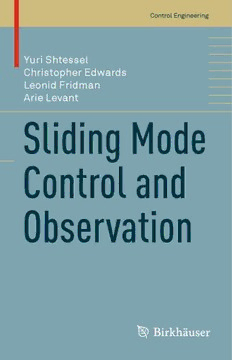Table Of ContentControl Engineering
Yuri Shtessel
Christopher Edwards
Leonid Fridman
Arie Levant
Sliding Mode
Control and
Observation
Control Engineering
Series Editor
WilliamS.Levine
DepartmentofElectricalandComputerEngineering
UniversityofMaryland
CollegePark,MD
USA
EditorialAdvisoryBoard
OkkoBosgra ManfredMorari
DelftUniversity ETH
TheNetherlands Zu¨rich
Switzerland
GrahamGoodwin
UniversityofNewcastle WilliamPowers
Australia FordMotorCompany(retired)
Detroit,MI
IoriHashimoto USA
KyotoUniversity
Japan MarkSpong
UniversityofIllinois
PetarKokotovic´ Urbana-Champaign
UniversityofCalifornia USA
SantaBarbara,CA
USA
Forfurthervolumes:
http://www.springer.com/series/4988
Yuri Shtessel • Christopher Edwards
Leonid Fridman • Arie Levant
Sliding Mode Control
and Observation
Y.Shtessel C.Edwards
DepartmentofElectricalandComputer CollegeofEngineering,Mathematics
Engineering andPhysicalScience
UniversityofAlabamainHuntsville UniversityofExeter
Huntsville,AL,USA Exeter,UK
L.Fridman A.Levant
DepartmentofControl DepartmentofAppliedMathematics
DivisionofElectricalEngineering SchoolofMathematicalSciences
FacultyofEngineering Tel-AvivUniversity
NationalAutonomousUniversityofMexico Israel
Mexico
ISBN978-0-8176-4892-3 ISBN978-0-8176-4893-0(eBook)
DOI10.1007/978-0-8176-4893-0
SpringerNewYorkHeidelbergDordrechtLondon
LibraryofCongressControlNumber:2013934106
MathematicsSubjectClassifications(2010):93B12,93C10,93B05,93B07,93B51,93B52,93D25
©SpringerScience+BusinessMediaNewYork2014
Thisworkissubjecttocopyright.AllrightsarereservedbythePublisher,whetherthewholeorpartof
thematerialisconcerned,specificallytherightsoftranslation,reprinting,reuseofillustrations,recitation,
broadcasting,reproductiononmicrofilmsorinanyotherphysicalway,andtransmissionorinformation
storageandretrieval,electronicadaptation,computersoftware,orbysimilarordissimilarmethodology
nowknownorhereafterdeveloped.Exemptedfromthislegalreservationarebriefexcerptsinconnection
with reviews or scholarly analysis or material supplied specifically for the purpose of being entered
and executed on a computer system, for exclusive use by the purchaser of the work. Duplication of
this publication or parts thereof is permitted only under the provisions of the Copyright Law of the
Publisher’slocation,initscurrentversion,andpermissionforusemustalwaysbeobtainedfromSpringer.
PermissionsforusemaybeobtainedthroughRightsLinkattheCopyrightClearanceCenter.Violations
areliabletoprosecutionundertherespectiveCopyrightLaw.
Theuseofgeneraldescriptivenames,registerednames,trademarks,servicemarks,etc.inthispublication
doesnotimply,evenintheabsenceofaspecificstatement,thatsuchnamesareexemptfromtherelevant
protectivelawsandregulationsandthereforefreeforgeneraluse.
While the advice and information in this book are believed to be true and accurate at the date of
publication,neithertheauthorsnortheeditorsnorthepublishercanacceptanylegalresponsibilityfor
anyerrorsoromissionsthatmaybemade.Thepublishermakesnowarranty,expressorimplied,with
respecttothematerialcontainedherein.
Printedonacid-freepaper
SpringerispartofSpringerScience+BusinessMedia(www.birkhauser-science.com)
Wededicatethisbookwithloveand
gratitudeto
Yuri’s wifeNina,
Chris’parentsShirleyandCyril,
Leonid’s wifeMillie,
Arie’s wifeIrena.
Preface
Controlinthepresenceofuncertaintyisoneofthemaintopicsofmoderncontrol
theory. In the formulation of any control problem there is always a discrepancy
between the actual plant dynamics and its mathematical model used for the
controllerdesign.Thesediscrepancies(ormismatches)mostlycomefromexternal
disturbances,unknownplantparameters,andparasiticdynamics.Designingcontrol
laws that provide the desired closed-loop system performance in the presence of
these disturbances/uncertainties is a very challenging task for a control engineer.
This has led to intense interest in the developmentof the so-called robust control
methods, which are supposed to solve this problem. In spite of the extensive and
successful development of robust adaptive control [159], control [48], and
backstepping [121] techniques, sliding mode control (SMHC)1remains, probably,
the most successful approach in handling bounded uncertainties/disturbances and
parasiticdynamics[67,182,186].
Historically sliding modes were discovered as a special mode in variable
structure systems (VSS). These systems comprise a variety of structures, with
rules for switching between structures in real time to achieve suitable system
performance,whereasusingasinglefixedstructurecouldbeunstable.Theresultis
VSS,whichmayberegardedasacombinationofsubsystemswhereeachsubsystem
hasafixedcontrolstructureandisvalidforspecifiedregionsofsystembehavior.It
appearedthattheclosed-loopsystemmaybedesignedtopossessnewpropertiesnot
presentinanyoftheconstituentsubstructuresalone.Furthermore,inaspecialmode,
named a sliding mode, these properties include insensitivity to certain (so-called
matched) external disturbances and model uncertainties as well as robustness to
parasiticdynamics.Achievingreduced-orderdynamicsofthecompensatedsystem
inaslidingmode(termedpartialdynamicalcollapse)isalsoaveryimportantuseful
propertyofslidingmodes.OneofthefirstbooksinEnglishtobepublishedonthis
subjectis[85].ThedevelopmentofthesenovelideasbeganintheSovietUnionin
thelate1950s.
TheideaofSMCisbasedontheintroductionofa“custom-designed”function,
named the sliding variable. As soon as the properly designed sliding variable
becomesequaltozero,itdefinestheslidingmanifold(ortheslidingsurface).The
vii
viii Preface
properdesignoftheslidingvariableyieldssuitableclosed-loopsystemperformance
whilethesystemtrajectoriesbelongtotheslidingmanifold.TheideaofSMCisto
steerthetrajectoryofthesystemtotheproperlychosenslidingmanifoldandthen
maintain motion on the manifold thereafter by means of control, thus exploiting
the main features of the sliding mode: its insensitivity to external and internal
disturbancesmatchedbythecontrol,ultimateaccuracy,andfinite-timeconvergence
oftheslidingvariablestozero.
Thefirstwell-citedtextinEnglishonSMCwasbyItkisandpublishedin1976
[113]. By 1980, the main contributions in SMC theory had been completed and
subsequentlyreportedin Utkin’s1981monograph(in Russian)andits subsequent
Englishversion[182].AcomprehensivereviewwaspublishedbyDeCarloetal.in
[56].Inthesepublications(seealsotheadvancedresultspresentedinthelaterworks
[186]and[67]),thetwo-stepprocedureforSMCdesignwasclearlystated.
The first step involves the design of a switching function so that the system
motion on the sliding manifold (termed the sliding motion) satisfies the design
specifications. The second step is concerned with the selection of a control law,
whichwillmaketheslidingmanifoldattractivetothesystemstate inthepresence
ofexternalandinternaldisturbances/uncertainties.Notethatthiscontrollawisnot
necessarilydiscontinuous.
SMC-based observers allow estimation of the systemstates in the presence of
unknown external disturbances, which can also be explicitly reconstructed online
byanobserver.
Control chattering still remained a problem impeding SMC implementation.
Addressingcontrolchatteringwas the main motivationfor the emergingso-called
second-ordersliding.Thus,thealreadymaturedconventionalSMCtheoryreceived
a significant boost in the middle of the 1980s: when new “second-order” ideas
appeared [132] and then, in the beginning of 2000s, when “higher-order” [124]
concepts were introduced. The introduction of these new paradigms was dictated
bythefollowingreasons:
1. The conventional sliding mode design approach requires the system relative
degreetobeequaltoonewithrespecttotheslidingvariable.Thiscanseriously
constrainthechoiceoftheslidingvariable.
2. Also, very often, a sliding mode controller yields high-frequency switching
control action that leads to the so-called chattering effect, which is difficult to
avoidorattenuate.
These intrinsic difficulties of conventional SMC are mitigated by higher-order
sliding mode (HOSM) controllers that are able to drive to zero not only the
slidingvariablebutalso its k 1 successive derivatives(kth-ordersliding mode).
!
The novelapproachis effective for arbitraryrelative degrees, and the well-known
chatteringeffectissignificantlyreduced,sincethehigh-frequencycontrolswitching
is“hidden”inthehigherderivativeoftheslidingvariable.
When implemented in discrete time, HOSM providessliding accuracy propor-
tional to the kth power of the sampling time, which makes HOSM an enhanced-
accuracy robust control technique. Since only the kth derivative of the sliding
manifoldisproportionaltothehigh-frequencyswitchingcontrolsignal,theswitch-
Preface ix
ing amplitude is well attenuated at the sliding manifold level, which significantly
reduceschattering.
The unique power of the approach is revealed by the developmentof practical
arbitrary-orderreal-timerobustexactdifferentiators,whoseperformanceisproved
tobeasymptoticallyoptimalinthepresenceofLebesgue-measurableinputnoises.
The HOSM differentiators are used in advanced HOSM-based observers for the
estimation of the system state in the presence of unknown external disturbances,
which are also reconstructed online by the observers. In addition HOSM-based
parameterobservershavebeendevelopedaswell.
ThecombinationofaHOSMcontrollerwiththeabove-mentionedHOSM-based
differentiatorproduces a robust and exact output-feedbackcontroller. No detailed
mathematicalmodelsoftheplantareneeded.SMCofarbitrarysmoothnesscanbe
achieved by artificially increasing the relative degree of the system, significantly
attenuating the chattering effect. For instance, the continuous control function
can be obtained if virtual control in terms of the control derivative is designed
in terms of SMC. In this case, the control function will be continuous, since it
is equal to the integral of the high-frequency switching function. In the case of
parasitic/unmodeleddynamicstheSMCfunctionwillswitchwithlowerfrequency
(thecontrolchattering).DesigningtheSMCintermsofthederivativeofthecontrol
functionyieldschatteringattenuation.
The practicality of conventional SMC and HOSM control and observation
techniquesis demonstratedby a large variety of applicationsthat include DC/DC
andAC/DCpowerconverters,controlofACandDCmotorsandgenerators,aircraft
andmissileguidanceandcontrol,androbotcontrol.
SMCisamaturetheory.Thistextbookismostlybasedontheclassnotesforthe
graduate-levelcoursesonSMCandNonlinearControlthathavebeentaughtatthe
Department of Electrical and Computer Engineering, the University of Alabama
in Huntsville; at the Department of Engineering, the University of Leicester; at
the Department of Control Engineering and Robotics, the Engineering Faculty,
theNationalAutonomousUniversityofMexicoandattheDepartmentofApplied
Mathematics, the Tel Aviv University for the last 10–15 years. The course notes
havebeenconstantlyupdatedduringtheseyearstoincludenewlydevelopedHOSM
controlandobservationtechniques.
Thistextbookprovidesthereaderwithabroadrangeofmaterialfromfirstprin-
ciplesuptothecurrentstateoftheartintheareaofSMCandobservationpresented
in a pedagogical fashion. As such it is appropriate for graduate students with a
basic knowledge of classical control theory and some knowledge of state-space
methods and nonlinear systems. The resulting design procedures are emphasized
usingMatlab/Simulinksoftware.
Fully worked out design examples are an additional feature. Practical case
studies,whichpresenttheresultsofrealslidingmodecontrollerimplementations,
areusedtoillustratethesuccessfulpracticalapplicationofthetheory.Eachchapter
isequippedwithexercisesforhomeworkassignments.

